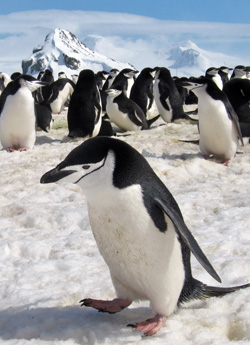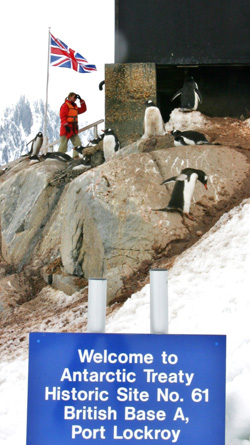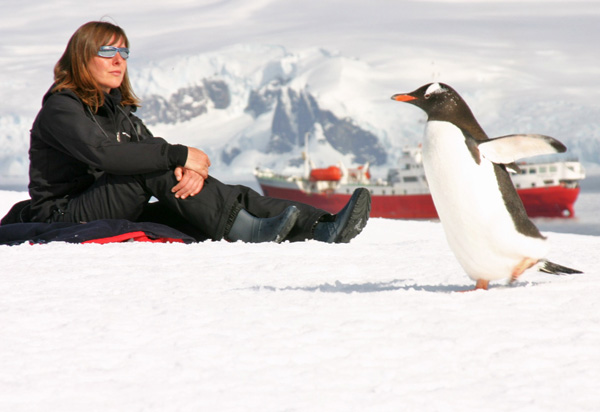USHUAIA, ARGENTINA - Visitors to this remote Argentinean debarkation port for Antarctic cruises are greeted with a hearty: Welcome to the end of the world - or to the beginning.
Antarctica has always been No. 1 on my bucket list. Whether to visit was not the issue; the question was when. Decisions, decisions:
The main method to travel to Antarctica is by cruise ship. Since landings are limited to 100 people simultaneously, that means splitting time with fellow passengers on larger ships. Then there are luxury liners that sail near the coast, but offer no land exploration.
Springtime visits (November to March) mean fewer ships jockeying for position at prime spots.
After the harsh winter the terrain is virtually untouched, making it likely you'll be the season's first to step onto many sites. And it's mating season, which means penguins are plentiful, but you won't see any newborns.
Late summer offers warmer (relatively speaking) weather, newly-hatched penguin chicks and more whales and seals, but since it's peak season, it means more ships, too.
Of course, I wanted an authentic adventure in a comfortable environment. So I joined a collection of international passengers aboard the M/V Antarctic Dream, a mid-size (80 passengers) exploration vessel, on the season's second outing in mid-November.


Left: Penguins own Antarctica and visitors must give way. Right: Former British research station now a souvenir shop.
The multi-national crew is enthusiastic and impressive. Expedition leader Jordi, from Spain, is a marine biologist who divides his time between the Arctic and the Antarctic. Zodiac master Maximiliano (Argentinean) advises:
Do not keep your eyes behind the camera. Take pictures with your mind. Keep them in your soul.
But our Chilean guide Cristina, summed it up best.
Antarctica is like going to another planet where animals receive you with a smile.
Going to Antarctica is no quick commute. Crossing Drake's Passage was a challenge. That's the stretch of water at the southern tip of South America where the Pacific and Atlantic Oceans inhospitably converge. But after two days of rolling from side to side, we awoke to calm. The view from the window-surrounded dining room revealed a winter wonderland.
Antarctica is one of the least hospitable places on Earth. It's the planet's coldest, highest, windiest, driest and iciest spot, and a land of mammoth proportions. Almost completely covered by an ice-cap accumulated over hundreds of thousands of years, it sends forth icebergs that can measure several kilometres in length.
There are no cities, no formal government (though international affairs regarding Antarctica are regulated by the 1959 Antarctica Treaty) and no permanent residents, other than penguin colonies, migrating whales, soaring sea birds and seals.
The animals are unafraid of humans; guests can wander freely among them, but not too closely. Get no closer than 15 feet to the animals, we're told.
Penguins don't know these rules so they may come closer. And if you have to cross a penguin highway, they have right of way.
Each day Jordi greets us with a cheery, Good morning, good morning, everybody. How are you? over the ship's intercom as a prelude to outlining the day's Plan A. Antarctica's unpredictable weather means there always has to be a Plan B and Plan C as well.
Our rewards were many: sitting among penguins; watching an iceberg break and flip; wading through knee-high snow during a continental landing and celebrating the event back aboard ship with champagne toasts and salsa dancing.

Above: Visitors get a warm welcome to Antarctica from the local penguin population.
At Half Moon Island, our zodiac approaches and we get our first sighting of penguins. We climb a snow-encrusted hill to observe a colony of Chinstrap penguins, which have a narrow band of black feathers under their chins, along with an Adelie penguin and a Macaroni penguin, with its characteristic yellow crest.
Barren Hannah Point had no snow, but plenty of animals, including a breeding colony of elephant seals, the largest species which can weigh more than two hippopotamuses.
Heavy ice conditions halted our progress as we aimed for Cuverville, so we switched to Plan B and made a continental landing in Selvick Cove, passing an ice floe with a majestic Emperor penguin perched atop it (they’re the birds who starred in the movie, March of the Penguins).
We were greeted by Cat at Port Lockroy, who said: "We have popped up on your ship from those little buildings over there, so welcome to Port Lockroy."
Cat is one of four seasonal staff members at the former British station which is now a historical museum with a gift shop (yes, they take credit cards) and the world's southernmost post office. They'll even stamp your passport.
During a two-hour zodiac tour among white, crystal-clear and intense blue icebergs in Cierva Cove, we spotted a weeks-old crabeater seal pup. Crabeaters are the Antarctic's most common seal, but since they inhabit the continent's pack-ice zone and are seldom on land, sightings are rare.
Snow flurries fly as we navigate between icebergs toward Lemaire Channel, where we reach the trip's southernmost latitude at 62 degrees, 2 minutes south.
Travellers to Antarctica earn premiere bragging rights, and more than 30,000 are expected this tourist season, the 100th anniversary of Roald Amundsen’s epic journey to the South Pole.
About the Author
Cynthia is a journalist and admitted addict — a travel addict. As a travel writer whose office is the world, she’s visited seven continents, 60 countries, countless cities and innumerable countrysides, where she’s attempted Argentina’s tango, canoed in the Amazon, ridden a Harley-Davidson throughMelbourne and sat amongst penguins in Antarctica. Born a Texan, she’s a long-time San Diego resident. In addition to TraveLife, credits include Time Magazine (Europe and Asia editions), Hemispheres, Costco Connection, Shape, Fit, Destinations Weddings & Honeymoons, and numerous newspapers. She also hosted the “No Passport Required” show on World Talk Radio and authored the book, “Get Your Travel Writing Published” (McGraw-Hill is the US/Canada distributor). Go to http://www.travelingcynthia.blogspot.com to see Cynthia's blog.